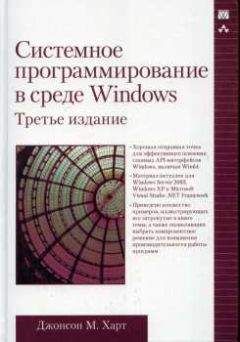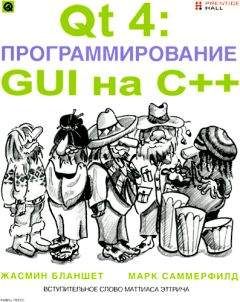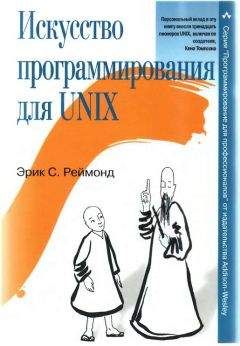Параллельное и распределенное программирование на С++ - Хьюз Камерон

Помощь проекту
Параллельное и распределенное программирование на С++ читать книгу онлайн
10. Cassell, Justine, Joseph Sullivan, Scott Prevost, and Elizabeth Churchill. Embodied ConversationalAgents. Cambridge, Mass.: MIT Press, 2000.
11. Chellas, Brian F. ModalLogic: An Introduction. New York: Cambridge University Press, 1980.
12. Coplien,James O. MuUi-Paradigm Design for C++. Reading, Mass.: Addison-Wesley, 1999.
13. Cormen, Thomas, Charles Leiserson, and Ronald Rivet. Introduction to Algorithms. Cambridge, Mass.: MIT Press, 1995.
14. Englemore, Robert, and Tony Morgan. BUickboard Systems. Wokingham, England: Addison-Wesley, 1988.
15. Garg, Vijay K. Principhs ofDistnbutedSystems. Norwell, Mass.: KluwerAcademic, 1996.
16. Geist, A1, Adam Beguelin, Jack Dongarra, Weicheng Jiang, Robert Manchek, and VaidySinderman. PVM:ParaUelVirtualMachine. London, England: MITPress, 1994.
17. Goodheart, Berny, andJames Cox. The Magic Garden ExpUiined: The Internak of Unix System VReUase4. New York: Prentice Hall, 1994.
18. Gropp, William, Steven Huss-Lederman, Andrew Lumsdaine, Ewing Lusk, Bill Nitzberg, William Saphir, and Marc Snir. MPI: The Compkte Reference. Vol. 2. Cambridge, Mass.: MIT Press, 1998.
19. Heath, Michael T. Scientific Computing: An Introduction Survey. New York: McGraw-Hill.
20. Henning, Michi, and Steve Vinoski. Advanced COBRA Programming with C++. Reading, Mass.: Addison-Wesley, 1999.
21. Hintikka,Jakko, and Merrill Hintikka. The Logic ofEpistemoU>gy and the EpistemoU>gy of LogTC.Amsterdam: KluwerAcademic, 1989.
22. Horty,John F. Agency andDeonticLogic. New York: Oxford University Press, 2001.
23. Hughes, Cameron, and Tracey Hughes. Mastering the Standard C++ CJmses. New York: JohnWiley, 1990.
24. Hughes, Cameron, and Tracey Hughes. Object-OrientedMuUithreading Using C++. New York:JohnWiley, 1997.
25. Hughes, Cameron, and Tracey Hughes. Linux Rapid Application Devebpment. Foster City, Calif.: M & T Books, 2000.
26. International Standard Organization. Information Technobgy: Portabk Operating System Interface. Pt. 1 System Application Program Interface. 2nd ed. Std 1003.1 ANSI/IEEE. 1996.
27. Josuttis, Nicolai M. The C++ Standard Boston: Addison-Wesley, 1999.
28. Koeing, Andrew, and Barbara Moo. Ruminations on C++. Reading, Mass.: Addison-Wesley, 1997.
29. Krishnamoorthy, C. S., and S. Rajeev. Artificial Intelligence and Expert Systems for Engineers. Boca Raton, Fla.: CRC Press, 1996.
30. Lewis, Ted, Glenn Andert, Paul Calder, Erich Gamma, Wolfgang Press, Larcy Rosenstein, and Kraus, Sarit. Strategic Negotiation in MuUitangent Environments. London: МГГ Press, 2001.
31. Luger, George F. ArtificialInteUigence. 4th ed. England: Addison-Wesley, 2002.
32. Mandrioli Dino, and Carlo Ghezzi. Theoretical Foundations of Computer Science. New York:JohnWiley, 1987.
33. Nielsen, Michael A., and Isaac L. Chuang. Quantum Computation and Quantum Information. New York: Cambridge University Press, 2000.
34. Patel, Mukesh J., Vasant Honavar, and Karthik Balakrishnan. Advances in the Evolutionary SynthesisofIntelligentAgents. Cambridge, Mass.: МГГ Press, 2001.
35. Picard, Rosalind. Affective Computing. London: MIT Press, 1997.
36. Rescher, Nicholas, and Alasdir Urquhart. Temporal Logic. New York: Springer-Verlag, 1971.
37. Robbins, Kay A., and Steven Robbins. Practical Unix Programming. Upper Saddle River, N.J.: Prentice Hall, 1996.
38. Schmucker, Kurt, Ander Weinand, andJohn M. VUssides. Object-OrientedApplication Frameworks. Greenwich, Conn.: ManningPublications, 1995.
39. Singh, Наггу. Progressing to Distributed Multiprocessing. Upper Saddle River, N.J.: Prentice Hall, 1999.
40. Skillicorn, David. Foundations of ParaUel Programming. New York: Cambridge University Press, 1994.
41. Soukup, Jiri. Taming C++: Pattern Ckisses and Persistence for Large Projects. Reading, Mass.:Addison-Wesley, 1994.
42. Sterling, Thomas L.,John Salmon, DonaldJ. Becker, and Daniel F. Savarese. How to Build a Bewoulf: A Guide to ImpUmentation and Application of PC Clusters. London: MITPress, 1999.
43. Stevens, Richard W. UNIX Network Programming: Interprocess Communications. Vol. 2, 2nd ed. Upper Saddle River: Prentice Hall, 1999.
44. Stroustrup, Bjarne. TheDesign andEvohUion of C++. Reading, Mass.: Addison-Wesley, 1994.
45. Subrahmanian, V.S., Piero Bonatti,Jurgen Dix, Thomas Eiter, Sarit Kraus, Fatma Ozcan, and Robert Ross. HeterogeneousAgentSystems. Cambridge, Mass.: МГГ Press, 2000.
46. Tel, Gerard. Introduction to Distributed Algorithms. 2nd ed. New York: Cambridge University Press, 2000.
47. Thompson, WilliamJ. ComputingforScientists andEngineers. New York:John Wiley, 1992.
48. Tomas, Gerald, and Christoph W. Uebeerhuber. Visualization of Scientific ParaUel Programming. New York: Springer-Verlag, 1994.
49. Tracy, Kim W. and Peter Bouthoorn. Object-Oriented: Artificial InteVigence Using C++. NewYork: ComputerScience Press, 1997.
50. Weiss, Gerhard. MultitagentSystems. Cambridge, Mass.: MFTPress, 1999.
51. Wooldridge, Michael. ReasoningAboutRationalAgents. London: MIT Press, 2000.
notes
Notes
1
POSIX— Portable Operating System Interface for computer environments— интерфейс переносимой операционной системы (набор стандартов IEEE, описывающих интерфейсы ОС для UNIX).
2
IEEE— профессиональное объединение, выпускающие свои собственные стандарты; членами IEEE являются ANSI и ISO.
3
) В оригинале написано «On the other hand, the distributed application in Figure 1-1 consists of three separate programs with each program executing on a separate computer». Что можно перевести как «С другой стороны, распределенное приложение на рисунке 1-1 состоит из трех отдельных программ, каждая из которых выполняется на отдельном компьютере» (Примечание пирата)
4
M.J. Flynn. Very high-speed computers. Из сборников объединения IEEE, 54, 1901-1909 (декабрь 1966).
5
MPP- Massively Parallel Processors (процессоры с массовым параллелизмом), SMP- symmetric multi-processor(симметричный мультипроцессор).
6
В оригинале «text segment», что принято переводить как «сегмент кода»
7
В оригинале - «Some hardware resources are preempted to allow different processes access»
8
В оригинале - «Therefore, once the thread exits, its resources, namely thread id, can be instantly reused» Exist & exits — все-таки разные слова
9
В оригинале следующее - «If the terminating thread did not make a call to pthread_exit(), then the exit status will be the return value of the function, if it has one; otherwise, the exit status is NULL» Под функцией в данном случае подразумевается функция, составляющая тело потока.
10
коду ошибки, на самом деле
11
Не макроса, а инициализации предопределенной константой, вообще-то
12
Правда, это не обеспечивает автоматически того, что исключение не будет возбуждено какой-либо функцией, вызванной данным методом.
13

























